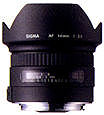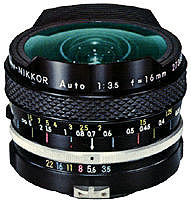| NOTE: In an attempt to revamp & rearrange content in this website, there is now a newly developed section featuring various MF Nikkor lenses, please bookmark the new site for future updates. As for SLR bodies, please refer to: - Nikkormat, Nikon EM/FG/FG20, FM series, FE Series, Nikon FA, Nikon F, Nikon F2, Nikon F3 & Nikon F4 |
The 15mm & 16mm wideangles & Full Frame Fisheye lenses of Nikon.

Don't get confused. This 15mm f3.5 is a true ultra wideangle (Optical expert may
not agreed, but compared with the Fisheye lenses, it is a wideangle lens for SLR.
A more approriate term should be a wideangle with Retrofocus design - I may have
to explain this later in another section), while the 16mm (see below) is a full frame
Fisheye-Nikkor (Pictures here are not to scale
in relation between the two).
* Full Frame means the eventual image will
fill the full and entire 35mm picture format with an angle of view of 180 degrees,
while the circular Fisheye lenses (see the 6mm
page) will provide (depends on focal length)
a circular image embraces by black border. 6mm, for instance, will
produces a subject view of 21.6mm (23mm for
the 8mm) diameter circle in the frame.
Here is an article of how to use 15mm ultrawide and 16mm fisheye Nikkor with the Nikon F4 Under the water !

The original Nikkor 15mm f5.6

Sigma's claimed - the fastest AF 14mm lens
(only refer to autofocus lenses, the widest is still a Nikkor, the 13mm!),
provide users with an more economical option,
uses an aspherical element within.

Ultra wideangle lenses render straight lines in the
subject as straight lines in the photograph. When combined with its extra and expansive
picture coverage, it is best used for photographing small interiors, large buildings
or panoramic landscapes. While the full frame fisheye provides a startling pictorial
effect because of its extreme barrel distortion. This manual 16mm lens
comes with a standard equipment which includes built in scalloped lens hood and a
set of 4 filters which bayonet onto the back of the lens.
All these lenses have immense depth of field generated with moderate aperture values. Thus, you may not find apertures smaller than F22. A f8 will span from a foot or two away to infinity (with proper guide with the aperture and depth of field scales marked on the lens barrel.
They have a very beautifully constructed compact AF version now (below):

Compared with the older version in the early part of '70:

Other pages containing Fisheye and ultrawide lenses in this site:
Older (6mm-10mm) & newer versions, 13mm Ultra wide

Not to dampened your spirit, Sigma's
economical offering, the 15mm fisheye lens...
Looks like all the third party lens manufacturers realises where the maket is, now the cake has to be shared,
Nikon started to offer more additional "values" to thir customers. Note
the constrcution of the lens of the Nikkor 16mm... it is getting better in cosmetic
as well (Sigma still uses their "Zen" finish).
| Back | to Main Index Page of
Lenses
![]()
* Message Board for your favourite lenses
Home - Photography in Malaysia
Copyright © 2000
leofoo® MIR Web Development Team
Credit: A combined contributing effort to
Michael Liu's Classic Nikkor lenses' site. A site dedicated
to a long lost friend on the
Net - Made with a PowerMac, broadcast with
a Redhat Linux
powered server. Cheers!